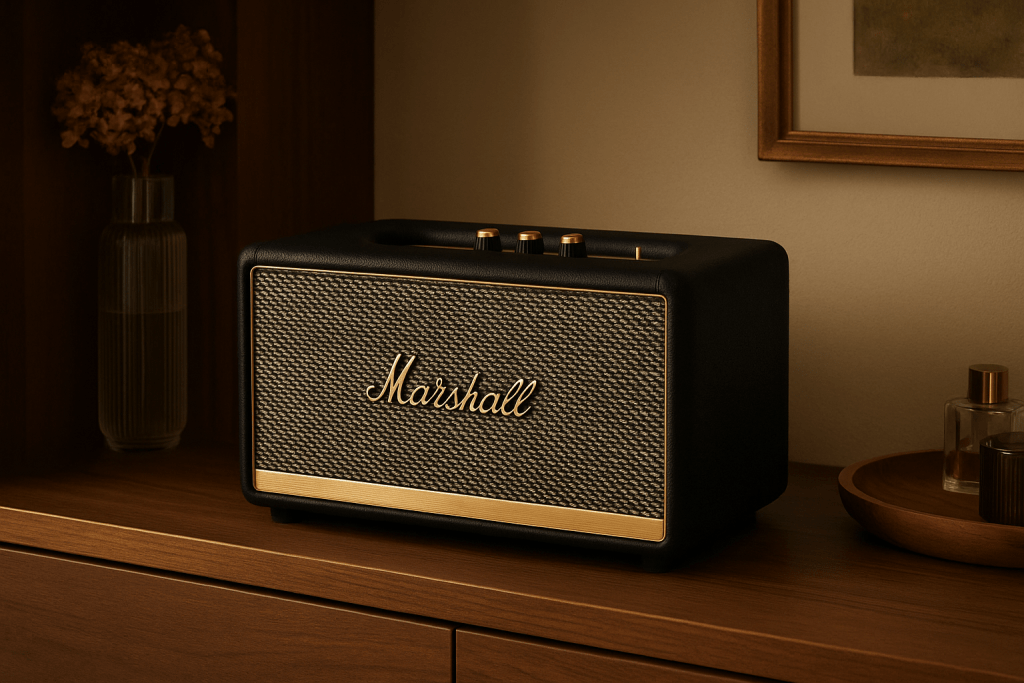Marshall Stanmore III Review — The Home Speaker with Amp Spirit
Share this article
Get Your Backstage Pass
If you loved the Acton III for being a compact “amp-style” home speaker, the Stanmore III steps it up — adding depth, scale, and presence while retaining that classic Marshall flair. It’s built to stay put (no battery) and fill your room (or more) with bold, characterful sound.
In a nutshell: A stylish, high-powered Bluetooth speaker designed for home use, blending vintage controls with modern amplification and audio “oomph.”
Design & Build
From the moment you see it, the Stanmore III is unmistakably Marshall. It echoes the look of a vintage guitar amplifier — rugged yet elegant. The cloth grille, brass accents, leather-like finish, and tactile knobs bring nostalgia and premium feel to life.
On top, you get physical knobs for volume, bass, and treble, plus a toggle switch / button to choose between inputs. These controls are nicely synced with the companion app so your digital adjustments reflect in the physical knobs.
Around back you’ll find RCA stereo inputs and a 3.5 mm aux jack, giving you wired flexibility for turntables, CD players, or TVs. One limitation: the Stanmore III is not portable — it lacks a battery and must remain plugged into AC power.
All told, this is a speaker built with longevity, presence, and tactile satisfaction in mind.
Setup & Connectivity
Setup is straightforward. You place the speaker, plug it in, and power it on via a satisfying flip switch. On your phone or device, connect via Bluetooth 5.2 (with aptX support) for wireless streaming.
The Marshall app offers a minimal interface. You can tweak EQ (bass / treble), and use a “placement compensation” setting (to tell the speaker whether it’s close to a wall/corner) to adjust bass response. The app’s features are somewhat limited beyond those core functions.
One small drawback: the speaker lacks smart-home / voice assistant integration (no Alexa/Google built in). Also, some users have reported intermittent Bluetooth latency or dropouts under certain conditions.
Still, for most use cases (music, casual listening, wired input), it works seamlessly.
Sound & Performance
This is where the Stanmore III really wants to shine — and for many listeners, it largely succeeds.
Tonal Character & Bass
Out of the box, the Stanmore III offers a bold, punchy low end and a bright treble presence. The low frequencies are deep and resonant, capable of pleasantly surprising rumble in many rooms — though when pushed extremely hard, distortion or “pumping” artifacts may creep in.
One trade-off: midrange / vocals tend to sit a bit behind in the mix, especially in the default EQ settings. This can make spoken words, podcasts, or vocals feel slightly recessed in some tracks. With user EQ tweaking (raising mids, reducing extremes), you can mitigate this.
Dynamics & Loudness
When you crank it, the Stanmore III has very respectable volume capability — it can fill large rooms while retaining clarity at many levels. That said, the first few volume steps can feel coarse (i.e. jumps are steeper), making fine control at low volumes a little finicky.
In loud scenarios, the speaker remains energetic and detailed, though some listeners note a softening in punch or impact as the volume approaches ceiling. DXOMARK+1
Stereo & Imaging
Marshall markets the Stanmore III as stereo-capable. However, as with many single-box speakers, true stereo separation is limited — the stereo “image” is present but not expansive. Still, Marshall’s angled tweeters and waveguides help spread sound across a wider field.
Test Bench & Measurements
In lab testing, DXOMARK rated the Stanmore III favorably in tonal balance and loudness, but flagged issues like midrange weakness, distortion at high SPL, and coarse early volume steps. STEREO Guide also rated it as “really mature” with great bass, ease of use, and solid build quality. stereoguide.com
Strengths & Weaknesses
What works really well
-
Bold, room-filling sound with character and “presence”
-
Deep bass and clear highs (with user-adjustable EQ)
-
Strong build and classic Marshall aesthetic
-
Physical knobs + tactile control that don’t feel gimmicky
-
Wired input options (RCA / 3.5 mm), useful for non-Bluetooth sources
Things to be aware of / potential limitations
-
No internal battery — not portable
-
Limited smart features / no voice assistant built in
-
Midrange / vocals may underperform in default EQ
-
Some distortion / artifacts at very high volumes
-
Coarse jumps in low-volume steps
Comparison: Stanmore III vs Acton III
-
The Acton III is more compact and better suited to smaller rooms or desktop use, while the Stanmore III brings more power, deeper bass, and broader stage.
-
Acton III sacrifices some volume and low-end for portability (or at least smaller footprint), whereas Stanmore III leans into being a dedicated home speaker.
-
In styling and control philosophy, both share that Marshall DNA (knobs, vintage vibes), but the Stanmore III is more ambitious in scale and ambition.
Verdict
If you’re looking for a stylish, powerful, home-oriented Bluetooth speaker with character — and you’re okay with it being stationary — the Stanmore III is a compelling pick. It offers more presence, richer lows, and more scale than compact models, while still retaining clarity and flexibility via EQ controls and wired inputs.
That said, if you’re especially focused on vocal clarity (podcasts, audiobooks) or want smart / voice features built-in, you’ll want to be ready to compensate (via EQ or pairing with another device). Also be mindful of the price point — for what it offers, it competes with high-end peers.
Overall: The Stanmore III leans into the spirit of a “living room amp-style” speaker — for those who want immersive audio with charm, not just a bland wireless box.
